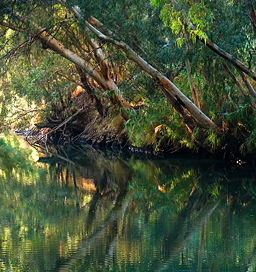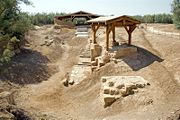Jordan River
- This article is about the Jordan River and its valley in western Asia.
- See also: Jordan Rift Valley and Jordan Valley (Middle East)
| River Jordan ( Arabic: نهر الأردنnahr al-urdun Hebrew: נהר הירדן, nehar hayarden) |
|
| River | |
 |
|
| Name origin: Greek: Ιορδάνης < Hebrew: ירדן (yardén, descender) < ירד (yarad, to descend)[1][2] | |
| Country | Israel, and Jordan |
|---|---|
| Tributaries | |
| - left | Banias River, Dan River |
| - right | Hasbani River, Iyon River |
| Landmarks | Sea of Galilee, Dead Sea |
| Length | 251 km (156 mi) |
 The Jordan River runs along the border between Israel, the West Bank and the Kingdom of Jordan
|
|
The Jordan River (Hebrew: נהר הירדן nehar hayarden, Arabic: نهر الأردن nahr al-urdun) is a river in Southwest Asia which flows into the Dead Sea. Historically and religiously, it is considered to be one of the world's most sacred rivers.[3] It is 251 kilometers (156 miles) long.
Contents |
Physical characteristics
Tributaries
- The Hasbani (Arabic: الحاصباني hasbani, Hebrew: שניר senir), which flows from Lebanon.
- The Banias (Arabic: بانياس banias, Hebrew: חרמון hermon), arising from a spring at Banias at the foot of Mount Hermon.
- The Dan (Hebrew: דן dan, Arabic: اللدان leddan), whose source is also at the base of Mount Hermon.
- The Iyon (Hebrew: עיון iyon, Arabic: دردره derdara or براغيث braghith), which flows from Lebanon.
Course
The river drops rapidly in a 75 kilometer run to swampy Lake Hula, which is slightly below sea level in the Galilee sea. Exiting the lake, it drops much more in about 25 kilometers to the Sea of Galilee. The last section has less gradient, and the river begins to meander before it enters the Dead Sea, which is about 400 meters below sea level and has no outlet. Two major tributaries enter from the east during this last phase: the Yarmouk River and Jabbok River.
Its section north of the Sea of Galilee (Hebrew: כינרת kinneret, Arabic: Bohayrat Tabaraya, meaning Lake of Tiberias) is within the boundaries of Israel, and forms the western boundary of the Golan Heights. South of the lake, it forms the border between the Kingdom of Jordan (to the east) and Israel and the West Bank (to the west).
Human impact

In 1964, Israel began operating a dam that diverts water from the Sea of Galilee, a major Jordan River water provider, to the National Water Carrier. Also in 1964, Jordan constructed a channel that diverted water from the Yarmouk River, another main tributary of the Jordan River. Syria has also built reservoirs that catch the Yarmouk's waters. Environmentalists blame Israel, Jordan and Syria for extensive damage to the Jordan River ecosystem.[3]
In modern times, the waters are 70% to 90% used for human purposes and the flow is much reduced. Because of this and the high evaporation rate of the Dead Sea, the sea is shrinking. All the shallow waters of the southern end of the sea have been drained in modern times and are now salt flats.
In September 2006, a problem arose with contamination: just downstream, raw sewage began flowing into the water. Small sections of the Jordan's upper portion, near the Sea of Galilee, have been kept pristine for baptisms. Most polluted is the 60-mile downstream stretch - a meandering stream from the Sea of Galilee to the Dead Sea. Environmentalists say the practice has almost destroyed the river's ecosystem. Rescuing the river could take decades, according to environmentalists.[3] In 2007, friends of the Earth Middle East named the Jordan River as one of the world's 100 most endangered ecological sites, due in part to lack of cooperation between Israel and the neighboring Arab states. [4]
Importance
The waters of the Jordan River are an extremely important resource to the dry lands of the area and are a bone of contention among Lebanon, Syria, Jordan, Israel and the Palestinians.
Transport
Route 90 connects the northern and southern tips of Israel and parallels the Jordan River on the western side.
Biblical importance
Tanakh
In the Bible, the Jordan is referred to as the source of fertility to a large plain ("Kikkar ha-Yarden"), called on account of its luxuriant vegetation "the garden of God" (Genesis 13:10). There is no regular description of the Jordan in the Bible; only scattered and indefinite references to it are given. Jacob crossed it and its tributary, the Jabbok (the modern Al-Zarqa), in order to reach Haran (Genesis 32:11, 32:23-24). It is noted as the line of demarcation between the "two tribes and the half tribe" settled to the east (Numbers 34:15) and the "nine tribes and the half tribe of Manasseh" that, led by Joshua, settled to the west (Joshua 13:7, passim).
Opposite Jericho, it was called "the Jordan of Jericho" (Numbers 34:15; 35:1). The Jordan has a number of fords, and one of them is famous as the place where many Ephraimites were slain by Jephthah (Judges 12:5-6). It seems that these are the same fords mentioned as being near Beth-barah, where Gideon lay in wait for the Midianites (Judges 7:24). In the plain of the Jordan, between Succoth and Zarthan, is the clay ground where Solomon had his brass-foundries (1 Kings 7:46).
In biblical history, the Jordan appears as the scene of several miracles, the first taking place when the Jordan, near Jericho, was crossed by the Israelites under Joshua (Joshua 3:15-17). Later the two tribes and the half tribe that settled east of the Jordan built a large altar on its banks as "a witness" between them and the other tribes (Joshua 22:10, 22:26, et seq.). The Jordan was crossed by Elijah and Elisha on dry ground (2 Kings 2:8, 2:14). Elisha performed two other miracles at the Jordan: he healed Naaman by having him bathe in its waters, and he made the axe head of one of the "children of the prophets" float, by throwing a piece of wood into the water (2 Kings 5:14; 6:6).
The Jordan was crossed by Judas Maccabeus and his brother Jonathan Maccabaeus during their war with the Nabatæans (1 Maccabees 5:24). A little later the Jordan was the scene of the battle between Jonathan and Bacchides, in which the latter was defeated (1 Maccabees 9:42-49).
New Testament

The New Testament states that John the Baptist baptized unto repentance[5] in the Jordan (Matthew 3:5-6; Mark1:5; Luke 3:3; John1:28). This is recounted as having taken place at Bethabara (John 1:28).
Jesus came to be baptized by him there (Matthew 3:13; Mark 1:9; Luke 3:21, 4:1). The Jordan is also where John the Baptist bore record of Jesus as the Son of God and Lamb of God (John 1:29-36).
The prophesy of Isaiah regarding the Messiah which names the Jordan (Isaiah 9:1-2) is recounted in Matthew 4:15.
The New Testament speaks several times about Jesus crossing the Jordan during his ministry (Matthew 19:1; Mark 10:1), and of believers crossing the Jordan to come hear him preach and to be healed of their diseases (Matthew 4:25; Mark 3:7-8). When his enemies sought to capture him, Jesus took refuge at Jordan in the place John had first baptized (John 10:39-40).
Gallery
Symbolic importance
The Jordan is a frequent symbol in folk, gospel, and spiritual music, or in poetic or literary works.
Because the Israelites made a difficult and hazardous journey from slavery in Egypt to freedom in The Promised Land, the Jordan can refer to freedom. The actual crossing is the final step of the journey, which is then complete. The Jordan also can signify death itself, with the crossing from life into Paradise or Heaven.
References
- ↑ "Jordan". NetBible. Retrieved on 2008-04-29.
- ↑ James Strong et alii (1890). "Jordanes". Strong's Greek Dictionary. Retrieved on 2008-04-29.
- ↑ 3.0 3.1 3.2 Ramit Plushnick-Masti. "Raw Sewage Taints Sacred Jordan River". Associated Press. Retrieved on 2007-04-10.
- ↑ "Endangered Jordan",Dateline World Jewry, World Jewish Congress, September, 2007
- ↑ Cf. Acts 19:4
See also
- Jordan River Crossing